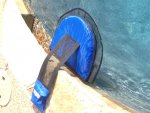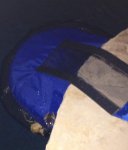As in my sig, pool is ~16.5Kgal, concrete / plaster (not sure how to tell the difference, or if it matters...) Sand filter, SWG, both of which are fairly new, and I'm still learning my way around them...
Swimmer load is fairly low (Me a few times a week) but I get a lot of plant debris, and an amazingly high number of drowned mice in the skimmer. I've been losing a fair amount of water from evaporation, but don't have much loss from splashout or otherwise.
I did a full water test today, with an elderly TFP test-kit, except for borates, where I've found the test strips to be pretty hard to read - I have some, but how much is a guess.... I add about 3 boxes when I open the pool, which I figure should make up for what I lose each fall when pumping it down...
Results -
OTO Cl 5+
pH 7.8
FAS/DPD 4
FC 0
TA 100
CH 270
CYA under 20
I'm using borates, the Compupool SWG says the levels are OK (I can barely taste salt)
A couple of weeks ago (7/10) the pool store tested and showed
FC 5.5 (I have since both decreased the % out on the SWG, and reduced the run-time for the main pump to 6hrs on / 6hrs off)
pH 7.8 (I added about 1/2 gallon of Muriatic Acid)
TA 106
CH 125 (I've added about 10-12lbs of Calcium chloride ice melter)
CYA 36
Salt 3075 (They used some sort of electrical meter for the test, not strips)
The water looks great.... I do have some "water-boatmen" bugs in it, but no other signs of life, and it is crystal clear.
My test results have been pretty consistent, and agree with the pool-store tests (for whatever that's worth) except for the CYA, which is the number I probably have the least faith in from my own tests, and I've felt that way since starting with TFP several years back...
Probably my biggest question is WHY do the suggested levels want the CYA for an SWG pool to be so much higher than they are for a pool that is just running bleach? Per the general chemistry descriptions, my understanding is that its best to have CYA levels that are just high enough to keep the chlorine from disappearing in daylight - why does having an SWG - which should keep the chlorine level better, raise the recommended CYA level? I note that per the Pool School CYA / Chlorine chart, I'd be in great shape if running bleach, but am marginal for an SWG even though that should (per the notes) need LESS chlorine?
Also, when I've been getting Muriatic Acid this year all I can find is stuff labeled as "safer" that has no Baum rating on the label, and is supposed to be lower fume than the "good" stuff.... Is there any reason not to use this variety - I'm not sure if it's as good at lowering pH, and I don't know what they might have put in it in order to make it "safer" and whether or not it would bother the pool. I've been using it so far, and not seen anything bad, but thought I'd ask...
ex-Gooserider
Swimmer load is fairly low (Me a few times a week) but I get a lot of plant debris, and an amazingly high number of drowned mice in the skimmer. I've been losing a fair amount of water from evaporation, but don't have much loss from splashout or otherwise.
I did a full water test today, with an elderly TFP test-kit, except for borates, where I've found the test strips to be pretty hard to read - I have some, but how much is a guess.... I add about 3 boxes when I open the pool, which I figure should make up for what I lose each fall when pumping it down...
Results -
OTO Cl 5+
pH 7.8
FAS/DPD 4
FC 0
TA 100
CH 270
CYA under 20
I'm using borates, the Compupool SWG says the levels are OK (I can barely taste salt)
A couple of weeks ago (7/10) the pool store tested and showed
FC 5.5 (I have since both decreased the % out on the SWG, and reduced the run-time for the main pump to 6hrs on / 6hrs off)
pH 7.8 (I added about 1/2 gallon of Muriatic Acid)
TA 106
CH 125 (I've added about 10-12lbs of Calcium chloride ice melter)
CYA 36
Salt 3075 (They used some sort of electrical meter for the test, not strips)
The water looks great.... I do have some "water-boatmen" bugs in it, but no other signs of life, and it is crystal clear.
My test results have been pretty consistent, and agree with the pool-store tests (for whatever that's worth) except for the CYA, which is the number I probably have the least faith in from my own tests, and I've felt that way since starting with TFP several years back...
Probably my biggest question is WHY do the suggested levels want the CYA for an SWG pool to be so much higher than they are for a pool that is just running bleach? Per the general chemistry descriptions, my understanding is that its best to have CYA levels that are just high enough to keep the chlorine from disappearing in daylight - why does having an SWG - which should keep the chlorine level better, raise the recommended CYA level? I note that per the Pool School CYA / Chlorine chart, I'd be in great shape if running bleach, but am marginal for an SWG even though that should (per the notes) need LESS chlorine?
Also, when I've been getting Muriatic Acid this year all I can find is stuff labeled as "safer" that has no Baum rating on the label, and is supposed to be lower fume than the "good" stuff.... Is there any reason not to use this variety - I'm not sure if it's as good at lowering pH, and I don't know what they might have put in it in order to make it "safer" and whether or not it would bother the pool. I've been using it so far, and not seen anything bad, but thought I'd ask...
ex-Gooserider





 but my home-built controller makes changing the run time pretty painless, just opening the box and flipping the right switches....
but my home-built controller makes changing the run time pretty painless, just opening the box and flipping the right switches....